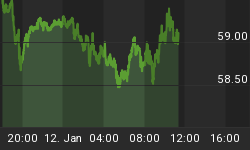Excerpt from April 26, 2007 PIVOTAL EVENTS
The April 11 ChartWorks on copper outlined that a number of technical readings were at the "bling" level. The one we liked is the "Sequential Sell" pattern which is a nice way to conclude a rally - particularly as the January low concluded the opposite; the "Sequential Buy" pattern.
As noted, copper's reversal was "right around the corner". So far the LME high has been 364.6 last Friday, which compares to the 407 reached on May 11, 2006.
With this our index (less nickel) made it to 760 on Tuesday which is a gain of 31 percent since the urgent selling in January drove it down to 581. On the same move nickel soared 60 percent from 32,800 to 52,370 on April 5. As the saying goes "not too shabby".
Aluminum rallied from 2700 in February to 2865, which compares to the high of 2950 made in January, and 3275 in May, 2006.
Zinc has rallied 25 percent from 3045 in early February to 3810 on Monday. This high compares to 4600 made in November.
From 1574 in January, lead gained 30 percent to 2045 on April 11. It has since slipped a little, but not enough to threaten the up trend.
Tin has been enjoying one of the biggest rallies in a hundred years.
TIN
FIVE BIG ONES (Adjusted by PPI)
Of course it is not yet known if the 14,590 is the peak for tin until further deterioration occurs. But in the meantime the gain at 223 percent is the biggest and it prompts one to wonder about such things. When it comes to profits for too many even the most outstanding gains are not enough. On the other hand, most are completely satisfied that they, personally, have sufficient common sense.
So much so that some more from someone else is often ignored.
By the same PPI calculation nickel is up 787 percent and the key now is that the final leg of bull markets for stocks and base metals (copper proxy) run against some 12 to 16 months of treasury curve inversion before completing.
April is Month 14 on that count and the hottest base metals are overdone in a big way.
The mining stock index (SPTMN) is at momentum levels that usually end rallies. Furthermore, the weekly RSI is showing a negative divergence against last week's high.
On the near term, Comex copper accomplished an outside reversal to the downside on Tuesday and has declined since. It is interesting when impetuosity exhausts itself and falls in one day. That's either up or down and while such reversals don't necessarily reverse a trend they are symptomatic of excesses.
Also, the big plays in nickel and tin seem to be faltering with Ni down 7 percent from 52,370 on April 5 to 48,600 today. The past two days accounts for a 6 percent drop.
Tin has dropped 7.8 percent from 14,695 on April 17 to today's 13,545.
Both were highly promoted so the set back along with what has been outlined above is interesting.
Producers can continue to sell further out and investors can increase the rate of selling base metal mining stocks.
Golds
Our concerns last week were based upon gold bugs, and the possibility of the dollar index finding stability as base metal prices started a seasonal decline.
This along with the possibility of silver beginning to underperform gold seems to be working out.
The gold correction could be modest and the next rally could be based upon changes in the financial markets. These are essential for a fundamental bull market in gold and include falling shortdated interest rates. T Bills have declined from 5.18 % on February 23 to this morning's new low at 4.94 %.
With this the treasury curve should changing from inverted to steepening. This has had a modest start.
The other essential change would be widening of credit spreads and in most sectors complacency is rampant.
However, it is worth emphasizing that gold's real price typically sets a cyclical low as the bull market for stocks and base metals sets a cyclical peak. In this regard our gold/commodities index, which was at 255 as the boom launched in mid 2003, suffered a relentless decline to 152. This represents not just a drop in purchasing power, but a proportionate decline in gold mining profit margins.
Our index set the low of 152 on April 5, recovered to 158 in midmonth and then hit 152 on Tuesday. Yesterday's post was 155, and going through 160 would establish a short-term recovery.
If accompanied by significant changes in the credit markets this could be the start of a cyclical bull market for the gold sector, from big caps to small caps.
Investors should be accumulating the sector on weakness.
Gold/Silver Ratio
Historically the ratio has a tendency to move with credit conditions - down during a boom and up on the contraction.
With the last regrettable example of the latter the ratio went from 52 in 1Q 2000 to 82 in mid 2003.
The key low close has been 46.8 on February 23 from which it recovered to 51.3 on March 5. Since, it came in to 48.7 on April 10 and then stayed around 49.5 for the past week.
The rise that began on February 23 along with the drop in bill rates led the China correction by a few trading days.
In the past week the ratio has increased from 49.2 to today's 50.8 as the bill yield has declined from 5.99 % to 4.94 %, which is beginning to suggest market exuberance is becoming vulnerable.
The gold/silver ratio rising above 51 would indicate diminishing speculative abilities in the stock and base metal markets.

















